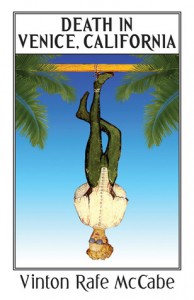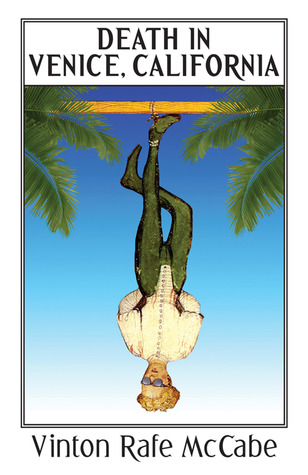 Death in Venice, California
Death in Venice, California
by Vinton Rafe McCabe
The Permanent Press. 192 pages, $28.
NOVELIST AND POET Vinton Rafe McCabe presents a compact story that’s as compelling as it is disconcerting. Though darkly comic and at times quite erotic, this is not a light read. It is, however, an elegantly written and artfully plotted gay novel that will make you think seriously about art, relationships, obsessions, ageism, philosophy, pornography, and sex.
At the center of Death in Venice, California is a character named Jameson Frame, a fifty-year-old writer of some renown, who has published exactly three works during his career: a pair of novels titled Pennyweight and The Antecedents and a very slim collection of poems called On Scrimshaw and Others. Beyond that, he’s a professor of creative writing at an unnamed university in New York City. For all his modest success, Frame suddenly finds himself dissatisfied with his life and disturbed by the endless gray, cold days in Manhattan from November till spring. So he heads west by commercial airplane and takes up an extended residence at the posh Hotel des Bains in Venice Beach, California.
Poised as he is on the liminal edge, it is difficult not to suspect that something momentous is about to happen to Frame as Death in Venice, California unfolds in its leisurely but insistent fashion. He very quickly meets two older women, Vera and Elsa, who are eccentric, new-age Bohemians at heart. At a party at their bungalow, Vera and Elsa introduce Frame to a youth named Chase who has pale skin studded with an array of tattoos, dark hair, sculpted muscles, and the surprisingly high-pitched voice “of a boy emanating from the body of a man.” The older Frame feels an almost immediate and overpowering lust/love for the much younger Chase. And it is that feeling that he chooses to act on despite his better judgment.
Chase is a product of the new millennium: a former underwear model who, lacking a real job, has created his own soft-core pornographic website, Chase.com, which is marketed with the cheesy—and not quite true—slogan: “I Want To Share My Whole Life With You.” Apparently, Chase.com appeals to a cadre of anonymous viewers willing to pay money to see Chase in a variety of erotic poses and situations. And there’s no small irony in the fact that Chase refers to his legions of fans as the “chasers.” As intrigued by and attracted to Chase as he is, it does not take much cajoling on the seductive Chase’s part to get Frame, or “Jimmy,” as the youth calls him, to film Chase as he showers and then masturbates using Frame’s ritzy room at the Hotel des Bains as a backdrop for Chase’s “art” (as he refers to it).
At Chase’s instigation, Frame also allows himself to be tattooed with an enormous letter “V”—for “vincible” (as opposed to an “I” for “invincible”)—on his leg. Meanwhile, encouraged by Vera and Elsa, he purchases a whole new wardrobe of outrageously expensive clothes, then undergoes liposuction in order to remove his paunch, and has both Botox and Masculane injected into his face to reduce the “stage-four crow’s-feet” around his eyes. These are clearly the actions of someone who is unable to think entirely rationally because of his obsession with a beautiful youth. Frame’s devolution climaxes in a seedy porn studio in Hollywood where he is filmed while fellating Chase for all the world—including the “chasers”—to see. This is the most physical intimacy that Frame will ever share with Chase.
With a title like Death in Venice, California, a happy ending is not, of course, in the cards. Frame’s fixation on Chase is such that he fails to take care of his own physical needs, notably the wounds incurred by the tattoos and the plastic surgery, which have left him losing blood, with the predictable result. The novel works due to McCabe’s skillful handling of his central character. Although the story is told from Frame’s perspective, the tone is matter-of-fact to the point of being clinical, allowing the reader to keep his distance from the narrator. Readers can sit back dispassionately and watch what happens to Frame, secure in the knowledge that they would never be so foolish as to sacrifice everything for a pretty face.
Death in Venice, California is McCabe’s homage to Thomas Mann’s 1912 novella. Like Gustav von Aschenbach, Frame is an aging writer who finds himself facing a crisis of the spirit, so he goes on a sojourn to a warmer, somewhat exotic climate, falls under the spell of a beautiful but unobtainable youth, and attempts to camouflage his age with the available tools. Both Frame and Aschenbach are fools in search of new experience—tragic clowns who make the mistake of losing themselves in profane love while ostensibly on a quest for art and beauty. In addition to tracing the consequences of Frame’s foolish choices, McCabe also considers the fate of Chase, a young man whose chances in life have been limited by no fault of his own, a beautiful youth who catches a break but who’s destined to be tossed aside by the next hot young thing to come along.
________________________________________________________
Anthony Guy Patricia is a doctoral candidate in English literature at the University of Nevada, Las Vegas.






